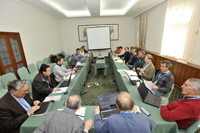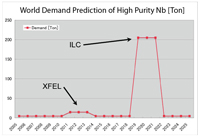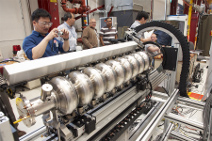 |
|
|
 |
ILC Detectors: more news since last IDAG meeting

IDAG meeting at Beijing in March 2010. Image: IHEP/Jie Liu
|
We have gained several helpful inputs from the new system of the International Detector Advisory Group (IDAG) monitoring global detectors after the validation. The IDAG report after the Beijing meeting suggests several new measures. Even during the discussion, we already received several useful remarks, some of which were described in my last article. I wish to add one more, namely the nature of the detailed baseline design report which we are going to produce in 2012 to summarise the entire activity of the Detector Letter of Intent (LOI) process. There was a question as to whom the document will be addressed to. Formally such report should be given to International Linear Collider Steering Committee, the mother body of the entire ILC activities. But the report will go further and we need to think more precisely who may actually read it and what it should contain. The question further indicated that we need to share a common idea on the nature of the detailed baseline document.
Read more...
-- Sakue Yamada
Research Director's Report Archive |
 |
|
|
 |
Discover Blogging ICHEP 2010, where bloggers attending the upcoming International Conference on High-Energy Physics in Paris this July are writing about their expectations. During the event, particle and astroparticle physics bloggers will contribute with a live commentary of the proceedings.
Don't miss the first posts!
|
 |
|
|
 |
| Upcoming meetings, conferences, workshops
LoopFest IX: Radiative Corrections for the LHC and Lepton Colliders
Stony Brook University Campus, NY, USA
21 June - 23 June 2010
TeV Particle Astrophysics 2010
Paris, France
19 July - 23 July 2010
35th International Conference on High Energy Physics (ICHEP2010)
Palais des Congrès, Paris, France
21 July - 28 July 2010
First Baseline Assessment Workshop
KEK, Tsukuba, Japan
7-10 September 2010
Upcoming schools
CERN Accelerator School (CAS 2010): Course on RF for Accelerators Ebeltoft, Denmark
8-17 June 2010
Fifth CERN-Fermilab Hadron Collider Physics Summer School
Fermilab, Batavia, IL, USA
16-27 August 2010
|
|
|
GDE Meetings calendar
View complete ILC calendar
|
|
|
 |
From DESY: Hamburg accelerates particle physics
Alexander von Humboldt professorship for university and DESY granted

Brian Foster |
The University of Hamburg and DESY have won a shared Alexander von Humboldt professorship for the development of accelerators and particle physics. The renowned award goes to Professor Brian Foster, currently head of Particle Physics at the University of Oxford in the United Kingdom, the Alexander von Humboldt Foundation and the Federal Ministry of Education and Research announced today. Assuming successful conclusions to negotiations, Foster will receive up to 5 million Euros over a period of five years to fund research into the development and realisation of acceleration technologies for particle physics and continued analysis of data from DESY's flagship accelerator, HERA.
Read more...
|
 |
|
|
 |
From National Geographic
16 June 2010
"God Particle" May Be Five Distinct Particles, New Evidence Shows
...Though "quite provocative," the results are still preliminary, Quigg stressed. “I know of nothing to make me explicitly doubt the result, but when something is so unexpected and yet so subtle it bears taking time and taking a deep breath,” Quigg said. “It's important not to jump up and down too soon about this.”...
Read more... |
|
From CNRS
15 June 2010
En juillet, la physique des particules est à la fête.
"Du jeudi 22 au mardi 27 juillet 2010, petits et grands pourront se familiariser avec la physique des particules à travers des animations grand public organisées dans le cadre de l'opération Paris Plage et la « Nuit des particules », soirée spéciale « science et cinéma » au Grand Rex le 27 juillet...."
Read more... (in French) |
|
From Fermilab
14 June 2010
New measurements from Fermilab's MINOS experiment suggest a difference in a key property of neutrinos and antineutrinos
"Batavia, Ill. - Scientists of the MINOS experiment at the Department of Energy's Fermi National Accelerator laboratory today (June 14) announced the world's most precise measurement to date of the parameters that govern antineutrino oscillations, the back-and-forth transformations of antineutrinos from one type to another. ..."
Read more... |
|
From Nature blog
14 June 2010
Experiments find "weird" differences between neutrinos and anti-neutrinos
"Neutrinos, the chargeless particles that course through your body every moment by the billion, should essentially behave the same way as their anti-particle, the anti-neutrino. ..."
Read more... |
|
From News Observer
14 June 2010
Tiny particles could solve a big mystery
"By the logic of science, things simply shouldn't exist. The best scientific minds of several generations have reasoned that shortly after the Big Bang created the universe, matter and antimatter should have wiped each other out...."
Read more... |
|
|
 |
 |
|
|
 |
Superconducting RF cavity industrialisation

Hiroaki Umezawa of Tokyo Denkai Co. showed how ILC will put very large new demands on the world production of high purity niobium |
Producing high gradient superconducting radiofrequency (SCRF) cavities that meet our demanding performance goals, are affordable and can be produced by industry represents one of the largest challenges on the way to making a solid project proposal for the ILC. The present 500-GeV ILC design requires about 18,000 nine-cell one-metre long niobium cavities (including spares) yielding an average operational field gradient of 31.5 megavolts per metre (MV/m). Although we can gain much experience from other projects (XFEL, Project X, etc) and from our own R&D programme, developing a worldwide capability to produce our cavities in industry represents an enormous challenge – one we need to address now. In that regard, a special satellite workshop on ILC cavity industrialisation was held in conjunction with the first IPAC meeting last month in Kyoto, Japan.
Read more...
-- Barry Barish
Director's Corner Archive |
 |
|
|
 |
What is it? Tune in!

Detail of a cavity tuning machine. Image: Thomas Zoufal, DESY
This one was tough for anyone who's never seen one of these, and blindingly obvious for those who have: the little motors, the track and the support structure are of course part of a cavity tuning machine. Congratulation to Toshi Shishido from KEK who was the first one to get the answer right. Tuning machines make sure that all the cavities' cells have the right shape to receive the radiofrequency waves that accelerate the particles. Four of these machine have been built at DESY, and two weeks ago the Fermilab-designed control racks arrived from the US. Machines and controls will be commissioned next week, and eventually one machine will be used for cavity tuning at Fermilab, one at KEK, and two at DESY or companies who work for DESY. Their first job is to get European XFEL cavities into the right shape, afterwards they will be used for ILC R&D.

Full view of the KEK cavity tuning machine. Image: Nobu Toge
|
 |
|
|
 |
ILC Report
2010-25
Report of the fourth meeting of the ILC Project Advisory Committee (PAC)
arXiv preprints
1006.3047
Overview of Spanish Tracking R&D for FLC
1006.2547
Physics requirements for Scalar Muons searches at CLIC
1006.2539
Luminosity Measurement at ILC
1006.2100
Direct and Indirect Detection of Neutralino Dark Matter and Collider Signatures in an SO(10) Model with Two Intermediate Scales
1006.1440
A Comprehensive Analysis of Electric Dipole Moment Constraints on CP-violating Phases in the MSSM
|
|

